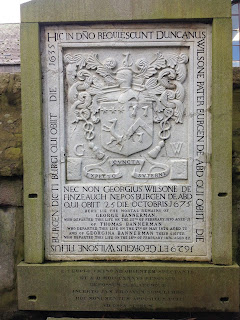St Nicholas Kirkyard, Aberdeen
Visited December 2017
The kirkyard (churchyard) of St Nicholas is right in the heart of Aberdeen, on the main shopping street, Union Street. I've visited here before, in the summer, but on a winter's day it's still lovely (if not somewhere to sit on a bench and ponder while waiting for a bus). The early graves were much clearer without their cloak of ivy from the summer, and somehow the leaves, moss and damp air made this feel more like a country churchyard than it does later in the year.
Around the walls of the kirkyard are the most impressive memorials, presumably to the great and the good. Many date to the 17th and 18th centuries, and there are some lovely heraldic arms, skeletons and ships dotted among the inscriptions. The main burial area is dominated by moss-covered table tombs as well as gravestones from the late 1700s onwards. The earlier ones are at the side nearest Union Street, with those over the other side (Schoolhill?) being a bit later and more staid.
Around the walls of the kirkyard are the most impressive memorials, presumably to the great and the good. Many date to the 17th and 18th centuries, and there are some lovely heraldic arms, skeletons and ships dotted among the inscriptions. The main burial area is dominated by moss-covered table tombs as well as gravestones from the late 1700s onwards. The earlier ones are at the side nearest Union Street, with those over the other side (Schoolhill?) being a bit later and more staid.



















































